Aircraft Participation
- D Day 80 - Heroes Remembered
- Aircraft Participation

Placid Lassie was built at Douglas Aircraft’s plant in Long Beach, California and delivered to the U.S. Army Air Forces in early 1943. They assigned her to the 74th Squadron, 434th Troop Carrier Group of IX Troop Carrier Command in England in preparation for D-Day.
On that fateful day, June 6, 1944, Placid Lassie, along with 832 other C-47s towed WACO CG-4A and AirCo Hadrian cargo gliders and dropped more than 24,000 paratroopers over Normandy. Thereafter, Placid Lassie participated in additional WWII combat engagements including: Operation MARKET GARDEN in the Netherlands (September 17- 25 1944), Operation REPULSE – the relief of Bastogne during the Battle of the Bulge (December 23-25, 1944), Operation
VARSITY (March 23, 1945).
Like many of her brethren following WWII, the aircraft went through a number of civilian owners, plying her trade as a cargo plane. This historic C-47 is now owned and operated by the Tunison Foundation ,a nonprofit organization. Placid Lassie is still equipped to drop paratroopers and she carries her original wartime name. Lassie and her crew appear at aviation events across the United States each year, including EAA AirVenture Oshkosh Charitable gifts to the foundation keep this aircraft flying as a living-history tribute to the greatest generation
C–47A–15–DK 42–92847 – That’s All, Brother – N47TB
This aircraft rolled of Douglas Aircraft’s production line in Oklahoma City, Oklahoma during the tail end of February, 1944, being delivered to the U.S. military on March 6th. She arrived in the UK, initially for service with the 8th Air Force, on April 26th, 1944, before transfer to the 9th Air Force the following day for service with the 87th Troop Carrier Squadron of the 438th Troop Carrier Group, based at RAF Greenham Common. Her crew nicknamed her That’s All, Brother. In the late hours of June 5th, 1944 That’s All, Brother took off as the lead ship in Serial #7, the initial element for the main U.S. paratroop force to go into battle in Normandy. The C–47, flown by Lt.Col. John Donalson, was carrying members of the 2nd Battalion, 506th PIR, 101st
Airborne Division towards Drop Zone A near Ste–Mère–Église, releasing them at around 00:48 hrs on June 6th. Later on June 6th, That’s All, Brother towed a glider full of troops to Normandy as well.
That’s All, Brother went on to serve, and survive, several further significant WWII combat missions including Operation Dragoon (the invasion of Southern France in July, 1944), Operation Market–Garden (Holland, September, 1944), the Siege of Bastogne (‘Battle of the Bulge’, Belgium in December, 1944) and Operation Varsity (the crossing of the Rhine into Germany during March, 1945).
Following WWII, she was declared surplus to requirements and placed up for disposal at Walnut Ridge, Arkansas in October, 1945.
She went through a number of civilian owners in the following half century before ending up with the Randsburg Corporation in Wisconsin, who dressed the historic transport up as a Vietnam War era AC–47 Spooky gunship of all things, not realising the history that lay hidden beneath her paint. After decades of use and abuse, the aircraft was very tired and in need of an expensive overhaul. Given the lack of knowledge about her history, it was really beyond economic sense to carry out the repairs, so she soon found her way into Basler Turbo Conversion’s bone yard, destined for conversion into a turbine–powered transport. Happily her true identity was discovered about ten years ago. After this, the Commemorative Air Force made a successful campaign to both acquire and restore the aircraft back into her pristine wartime condition. She is now based in San Marcos, Texas with the Central Texas Wing of the Commemorative Air Force.
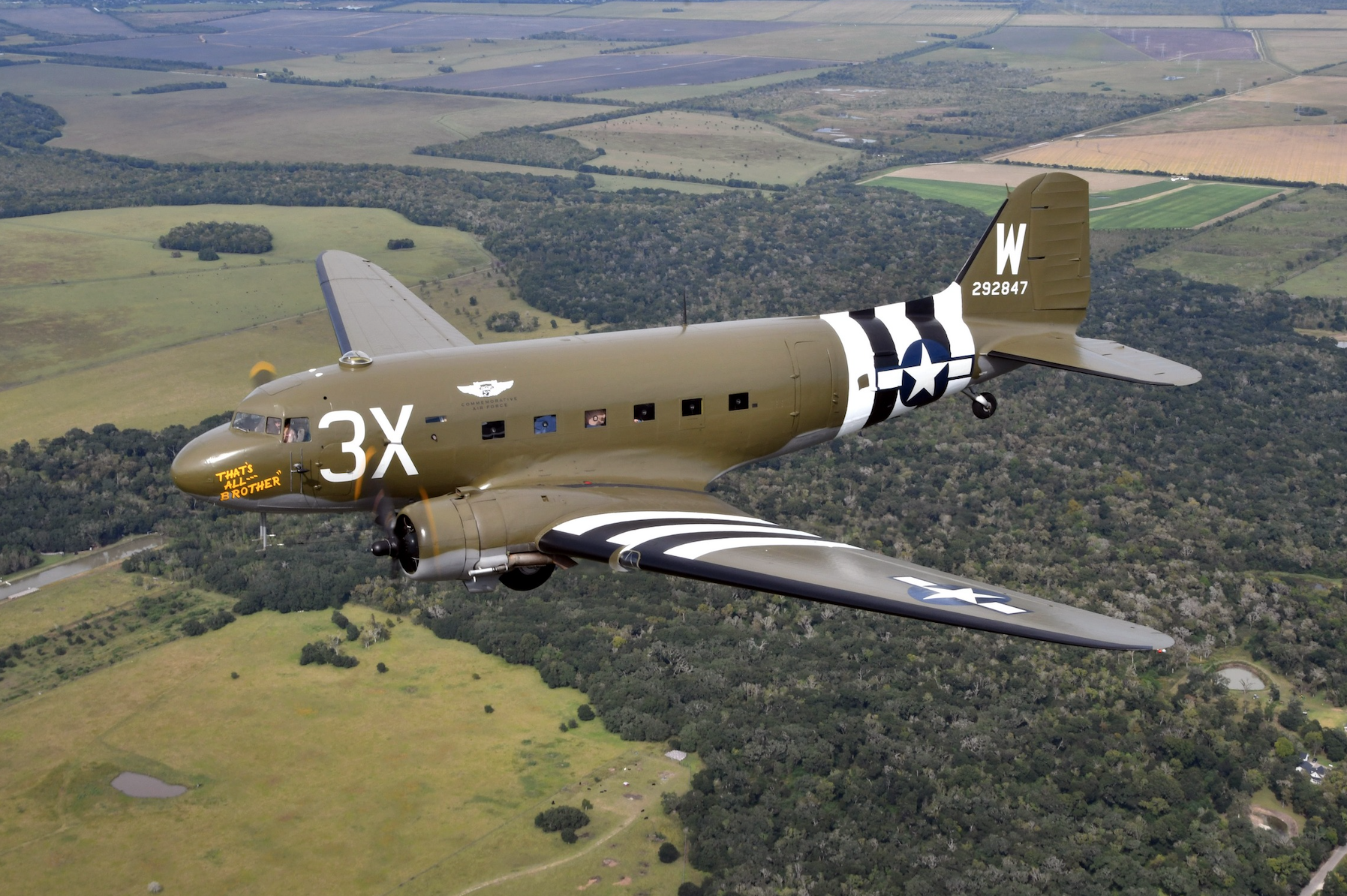
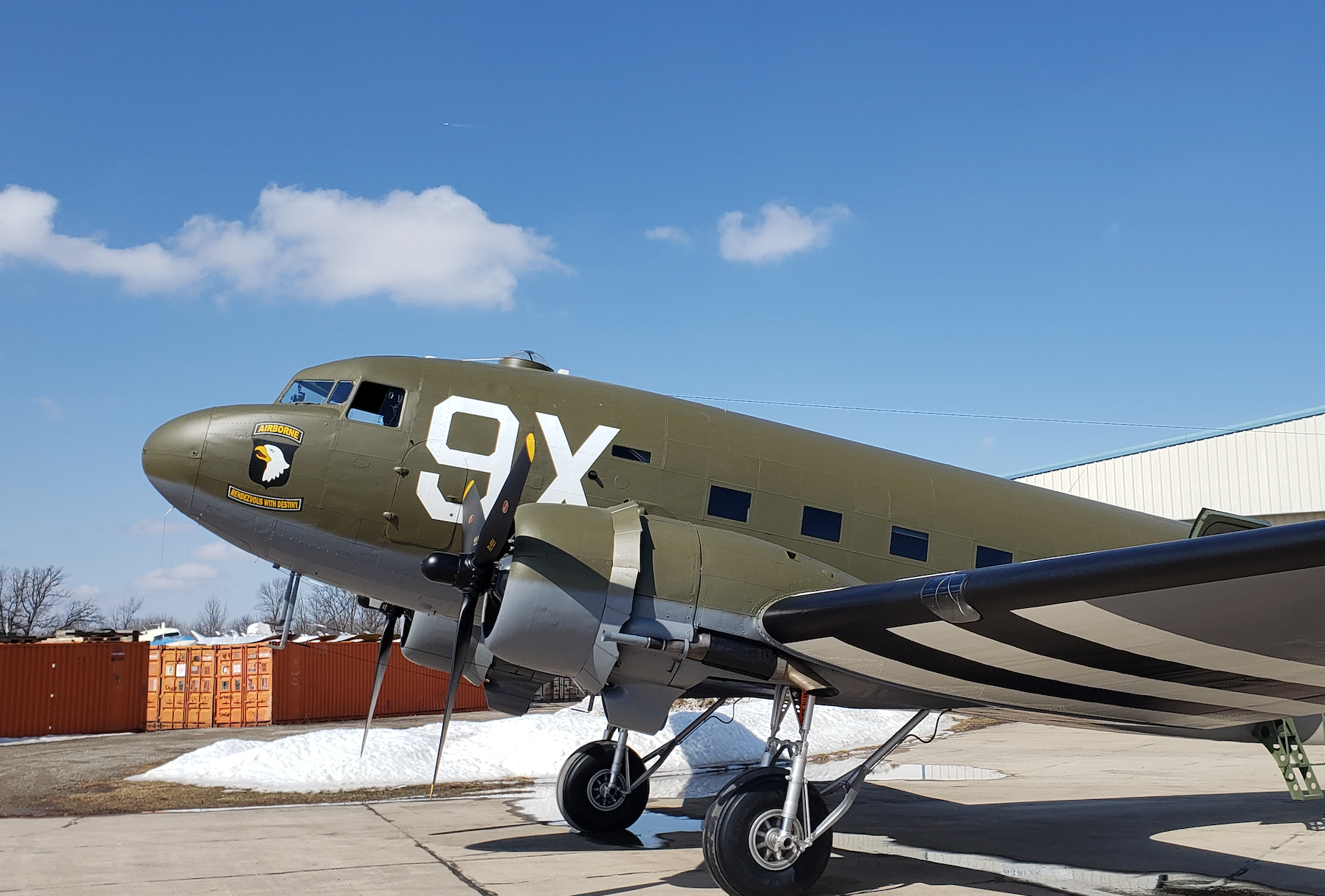
C-47-DL 41-18401 – Screaming Eagle – N150D
This aircraft was originally ordered as a DST, or Douglas Sleeper Transport, in 1941. However, with the U.S. Army Air Forces took over her contract, impressing her for war service before her completion. She was delivered to the USAAF as C–47 41–18401 at Douglas Aircraft’s Factory in Long Beach, California on June 23rd, 1942 one of very few C–47s completed at this facility. The aircraft never became part of a formal military squadron however, heading straight into service with Pan American Airways on July 2nd, 1942. She served mostly out of North Africa and the Middle East at this time.
Following WWII, the aircraft was transferred to the French Air Force, joining them on November 20th, 1945 and serving faithfully for the next two decades before being sold on to the Israeli Defense Forces (IDF) in January, 1967. There is some indication that the aircraft served with the Ugandan Air Force for a period before her retirement from the IDF in November, 1995.
The aircraft then appears as N155JM on the U.S. civil registry in August 1999, with Global Aircraft Industries of Phoenix, Arizona. The Ozark Airlines Museum in St.Louis, Missouri then acquired the DC–3 in October, 2001. Her present owner purchased the aircraft 3 or 4 years ago, being drawn to the aircraft because it still had the radio operator and navigators areas with bulkheads and a celestial dome. Over the years, almost all of these aircraft have had these items removed, so to find one so complete and authentic was quite astonishing. The owner commissioned Basler Turbo Conversions to bring the aircraft to Oshkosh for a restoration and have it completed for the D–day 75th. The restoration work was extensive. Over the span of a little over two years, the wings were almost completely rebuilt, the fuselage and center wing extensively repaired, while the fuel tanks and landing gear were also overhauled. All of the flight controls were overhauled and re–covered along with corresponding stabilisers. All of the fuel lines and electrical wiring were replaced and the hydraulic system was about 95% replaced. Modern avionics were installed in a new instrument panel that now includes a pair of Garmin 750 GPS along with Garmin transponders with ADSB, TCAS and SATCOM. All in all, Basler put close to 40,000 man hours into the restoration. The aircraft went to the paint shop in mid–January, 2019 and it was ready to go by March 7th.
SPITFIRE MKIX TD314
TD314 was built at Castle Bromwich in late 1944 and fitted with a Merlin 70 as a High Level Fighter (HFIXE). She was one of the last high back Spitfires built as the production line switched to low back aircraft in February of 1945. She was delivered to 33 MU at Lyneham on 30th March 1945, transferring later that month to 30 MU before a further move to 6 MU where she was prepared for service with 183 (Gold Coast) Squadron at Chilbolton on the 24th June 1945. 183 squadron only kept its Spitfires for a short time before re–equipping with Tempests.
TD314 moved to 234 (Madras Presidency) Squadron at Bentwaters on 26th July 1945, it is in this squadrons colours that she is currently finished with the squadron codes of FX–P. Whilst with 234 squadron it is possible that TD314 took part in the 1945 Battle of Britain flypast over London. When 234 squadron converted to Meteors TD314 was transferred to 29 MU at High Ercall for disposal on the 27th February 1946.
In early 1948 TD314 was selected as one of the 136 Spitfire IXs to be sold to the South African Air Force and she was sent to 47 MU RAF Sealand where she was packed for shipment, leaving Birkenhead on the SS Clan Chattan 23rd April and arriving at Cape Town on the 12th May 1948. Details of her use with the SAAF are not known but she was sold for scrapping to the South African Metal & Machinery CO, Salt River, Cape Town, sometime during 1954. She remained in the scrap yard until recovered by Larry Barnett of Johannesburg in 1969. From there she passed through the hands of several owners before arriving in the UK via Canada in 2009.
Acquired by Aero Legends in 2011, restoration commenced at Biggin Hill culminating in a first flight on the 7th December 2013. TD314 is heavily featured in the new Haynes manual on Spitfire restoration having its picture pride of place on the front cover. TD314 has been named “St. George” which is prominently displayed on the fuselage

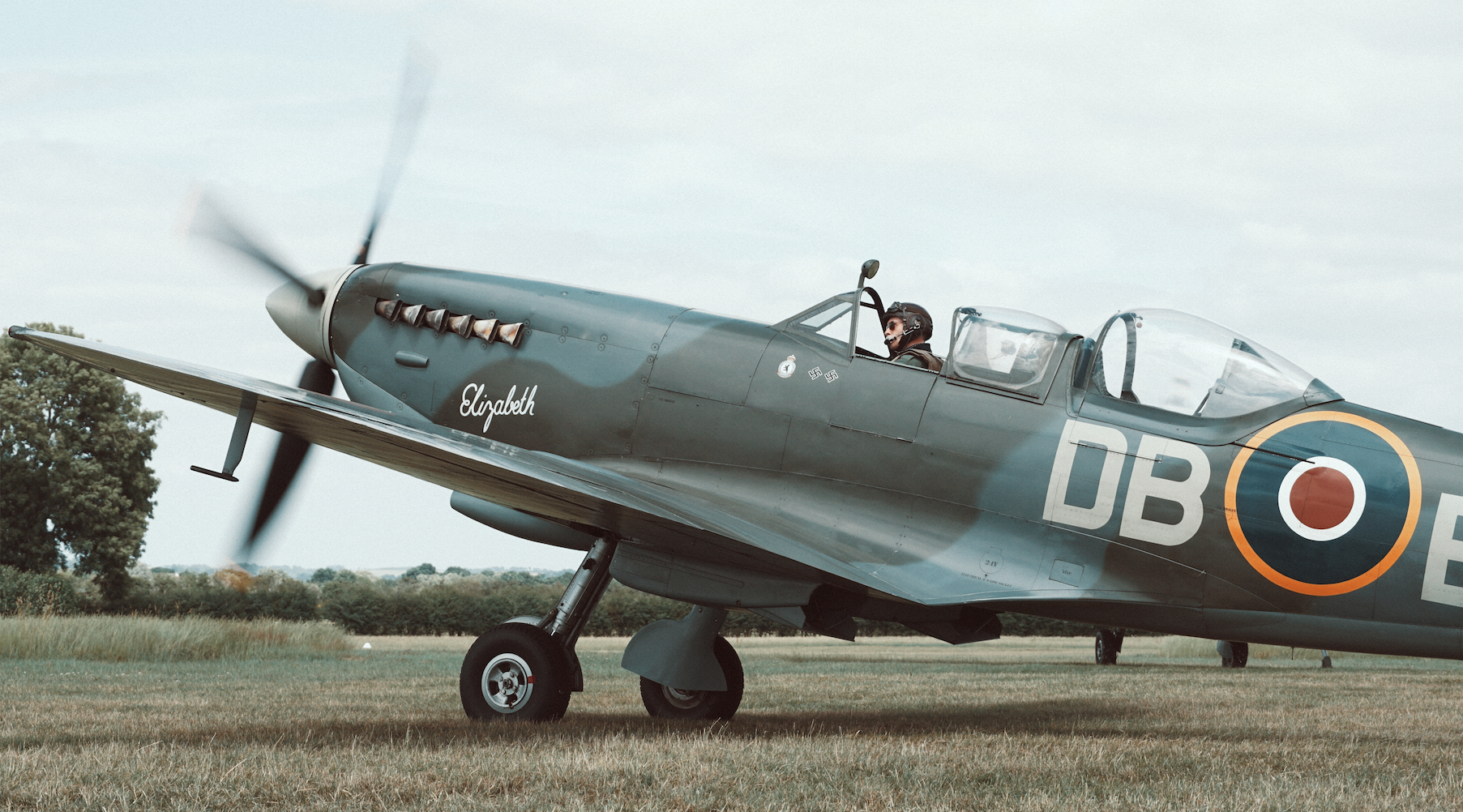
SPITFIRE MK IXT NH341 ‘Elizabeth’
Spitfire NH341 was built at Castle Bromwich as a Spitfire Low Level Fighter (LFIXE) and delivered to 8 MU on the 28th April 1944. It was sentto Miles Aircraft for modifications to be fitted before delivery to 411 (Grizzly Bear) squadron RCAF on 12th June 1944.This was the only squadron NH341 served with and was flown by 9 pilots. The most notable use of NH341 was in the hands of Flt Lt HughCharles Trainor who gained his third kill in 48 hours on 29th June 1944 when he downed an ME109 five miles West of Caen whilst flying her.Flt Lt Trainor destroyed another ME109 on the evening of 30th June 1944 over Thury Hurcourt, again in NH341.Flt Lt Trainor gained ace status later flying another Spitfire when he destroyed two more ME109s in a single flight on the 4th July, this was after NH341 had been lost on the 2nd July whilst being flown by W/O J S Jeffrey who escaped unscathed after tangling with FW190s South East of Caen.
The substantial remains were placed on display at the Musee Memorial de la Bataille de Normandie at Bayeux during 1996. It was later displayed at the Juno Beach Museum at Courseulles–sur–Mer during 2003 where it was described as being ML295. Inspection of the aircraft however shows that a substantial amount of the parts originated from NH341 with only a few parts from another Spitfire. NH341 was delivered to 411 Squadron’s airfield at B4 Beny sur Mer near the Normandy coast shortly after D Day (6th June 1944) on 12th June 1944, flying its first sortie on 14th June. NH341 made 27 operational combat flights over the post D Day battlefields in the hands of 9 pilots. F/L Trainor scored two air victories in NH341 against ME109s on the 29th and 30th June.
A summary of the missions undertaken by NH341 were as follows;
- 1 escort to Lancaster bombers on a mission to Le Havre to attack E boats.
- 10 patrols over the Normandy beach head.
- 8 armed reconnaissance patrols.
- 2 bridgehead patrols.
- 1 fighter sweep.
- 2 dive bombing missions.
- 3 front line patrols.
The fuselage of NH341 arrived at Historic Flying Ltd, based at The Imperial War Museum Duxford in July 2015. The restoration of this historic aircraft has been completed in a two seat MK IXT configuration to allow Aero Legends customers to experience flying in a Spitfire. The colour scheme and equipment are designed to mirror as closely as possible NH341 flying with the Canadian pilots of 411 Squadron.
SPITFIRE MK IXT MJ444
Spitfire MJ444 is a Mk IX Spitfire built at Castle Bromwich in 1943. She served in 403 Sqn RCAF, 443 Sqn RCAF and 411 Sqn RCAF like her sister aircraft, NH341 ‘Elizabeth’.
Spitfire MJ444 served with 411 Sqn RCAF from 21st September 1944 before transferring 403 Sqn RCAF. During her time with 403 Sqn she was flown by Flying Officer Mac Reeves and extensively by Flying Officer Stephen Butte DFC under the leadership of Wing Commander ‘Johnnie’ Johnson. F/O Stephen Butte is shown photographed at North Weald, in 1944 and upon his return in 2002 in one of the revetments now used for Aero Legends flying experiences.
MJ444 was then transferred to 443 Sqn on the 14th December 1944 while both Squadrons were based at B.56 Evere (Belgium). She was flown by both Pilot Officer Gomm and Flt Lt E H Fairfield who successfully bailed out of the aircraft on the 13th January 1945 after being hit by flak near St Vith.
Spitfire MJ444 will be restored to a two-seat dual control trainer configuration over 26 months. Following an assessment of our options, we’re delighted to once again be working with the market leaders in warbird (specifically Spitfire) restoration, The Aircraft Restoration Company who will oversee the restoration to flight and the following test flight programme. They have not only restored the finest Two-Seat Spitfire flying, NH341 ‘Elizabeth’, but are responsible for the restoration of the Silver Spitfire which recently circumnavigated the earth and own, restored and operate the ‘NHS’ Spitfire.
Airframe Assemblies will be rebuilding a range of key components for the restoration and will be instrumental in Spitfire MJ444’s return to flight. Our in house engineering division, Vintage Aero will be providing their assistance to rebuild a number of key components.


C47 DAKOTA ‘DRAG ‘EM OOT’
‘Drag ’em Oot’, a 1944 C-47 Douglas Sky Train. This Douglas C-47 c/n 19345, was delivered to the United States Army Air Force on 28 December 1943 and had serial 42-100882 assigned. She joined operations with 87th Troop Carrier Squadron based at Greenham Common in England equipped as glider pick up, her crew named her Drag ’em Oot (slang for ‘Drag Them Out’). She participated in the air assault during D-Day when at 00:46 on 06 June 1944 she dropped 18 paratroopers of the US 82nd Airborne Division just behind the Normandy beach heads, near St. Mere Église. She returned safe to the UK and after a second mission that very same day, she started to resupply the troops in France.
In September 1944 she was transferred to the RAF, designated a Dakota C.3 and assigned the British serial TS422. Once with the RAF she was assigned to Number 1 Heavy Glider Servicing Unit, attached to 38 Group RAF at Netheravon, Wiltshire. The RAF wanted to have a specialist glider recovery unit and TS422 started recovering Horsa assault gliders from the Normandy beach heads as soon as she joined the RAF. The unit recovered about 40 Horsa’s prior to Operation Market Garden. TS422 herself was just like the Horsa’s she recovered from the Normandy beaches, in action during the biggest paradropping in history: Operation Market Garden in September 1944. During this mission the pilot must have been severely wounded considering this Dakota was found to have signs of 12 bullet holes on the top of her cockpit and nose; probably caused by being attacked by a German fighter at some point but this Dakota warbird could take a beating. She was repaired and in August 1945 she joined 435 Squadron of the Royal Canadian Air Force which had just returned from Burma to the UK.
After the war ended the Dakota left for Canada, where she served with the RCAF as a trainer, a transport and whilst equipped with skis and jato rockets, as a search and rescue aircraft.
After her fruitful military career she ended up in the USA, serving with various civilian companies, being registered as N5831B. She was then grounded for a few years until Paddy Green found her in Arizona upon his search for a C-47 to be restored as a WW2 veteran.
Following an inspection (plenty of DC-3 / C-47 hulks around but most are in deplorable shape when inspected thoroughly) she was purchased and prepared to a condition suitable for the long ferry flight back to England. The flight to Liverpool took 7 days and 35 hours flying time, but occurred without any technical problems.
Once in the UK she was registered N473DC and repainted in the livery she now appears in: the original markings as worn during her missions on D-Day 1944 with USAAF serial 42-100882 and coded 3X-P, nicknamed Drag ’em Oot (slang for ‘drag them out’) then piloted by Bill Allin.
‘Drag ’em Oot’ will be kept in military trim and used by Aero Legends in a number of roles including parachuting, air displays and in support of the soon to be launched re-enactment business – Combat Legends Ltd. ‘Drag ’em Oot’ will remain hangared at Lincolnshire Aviation Heritage Centre for the foreseeable future. Aero Legends is also searching for a passenger configuration DC-3 and will have news on this soon.
C47 Dakota ‘Pegasus’
It was from the Douglas plant in Oklahoma City that serial 44-77104 emerged in 1945.Taken on strength initially by the AAF, a few days later it was handed over to the RAF in Montreal, thus becoming a Dakota IV with serial KP220. Once ferried to the UK, it
joined No 435 Squadron, RCAF at Down Ampney, moving to Croydon that December for operation by the air officer commanding No 46 Group. With No 24 Squadron at Bassingbourn from March 1947, KP220 flew on the 1948-49 Berlin Airlift.
Having been struck off RAF charge in November 1950 and stored by No 22 Maintenance Unit at Silloth, the aircraft was registered as G-ANAF to BKS Air Transport during June 1953. Hunting Surveys bought ’AF in November 1958 and used it
until April 1973, when the machine was retired and brought to Duxford for preservation by the East Anglian Aviation Society; it was one of the aircraft there when the museum premises were first opened to the public for an air day in October 1973.
However, 1977 saw ’AF being revived. It was serviced at Exeter, and sold to the then nascent Air Atlantique, not least for employment on a Post Office contract. For a time it was also operated by subsidiary carrier Air Luton. After that Air Atlantique used the aeroplane again from its Coventry base as a transport, a pollution control sprayer, and latterly for Racal/Thales radar test work with a large under-fuselage radome. With the gradual break-up of the Atlantique fleet, ’AF was first leased, and then in 2015 sold, to spin-off company RVL.
Following a period on the ground, it was restored to airworthiness at Coventry by Ben Cox and his team at Heritage Air Services, flying again on 5 June 2019. The next day, it made the cross-Channel trip to Normandy to join the D-Day 75th anniversary events. The Dakota was registered to Aero Legends in September of that year.
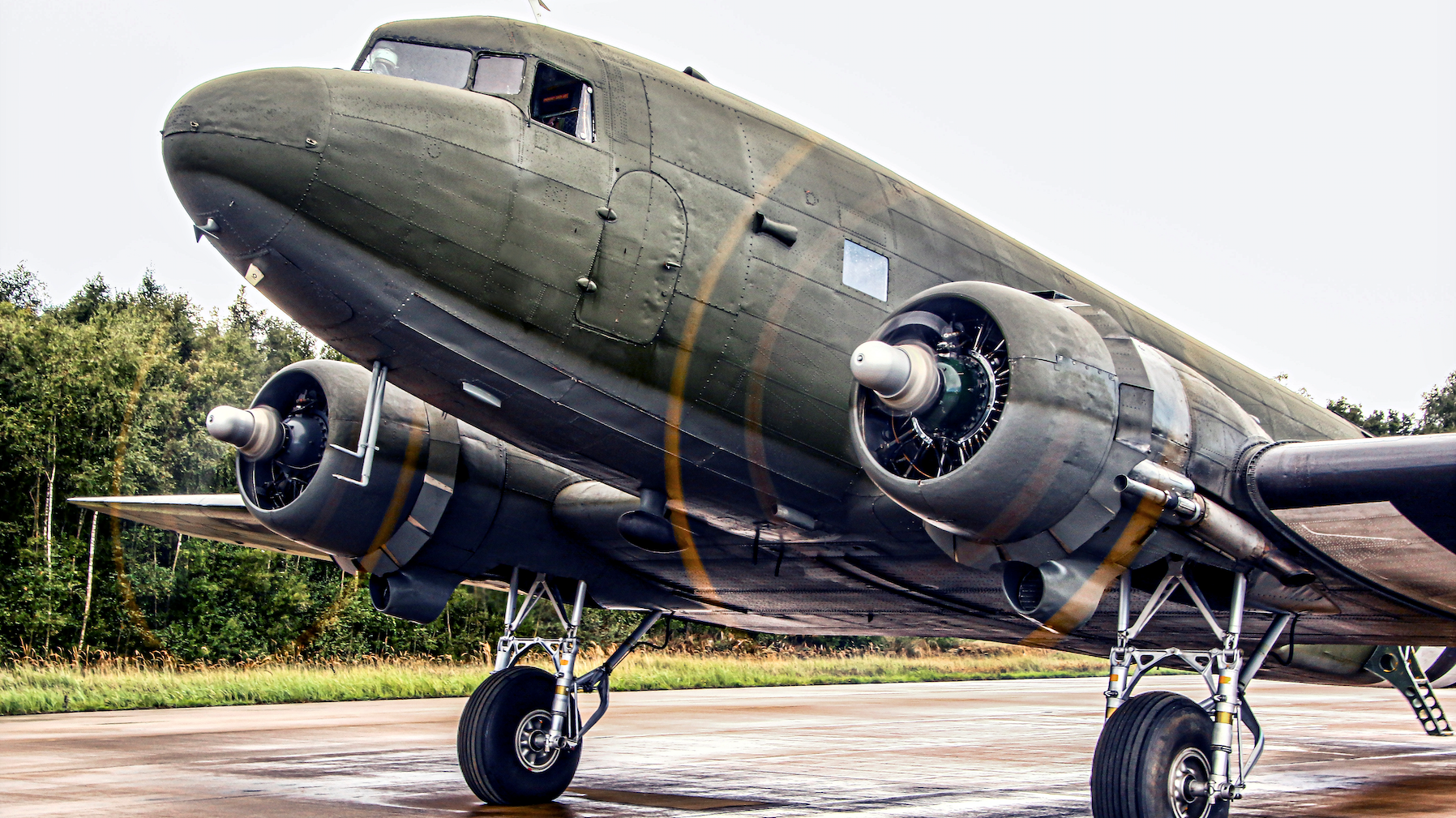
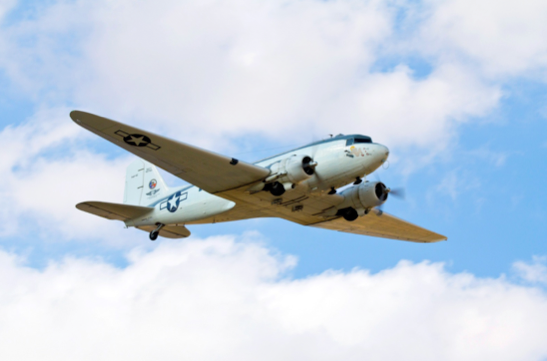
Ready 4 Duty
Built as a DC-3 passenger transport, ‘Ready-4-duty’ was converted for use by the U.S. Navy Atlantic Special Service Squadron and used for airborne search radar and sonar evaluation training across the Atlantic Ocean. Known as a R4D by the U.S Navy, the aircraft was used for long range maritime duties. Today the aircraft is maintained to promote the wider use of the DC-3 aircraft but keeps its Atlantic paint scheme.
Spirit of Douglas
Designed as one of over 300 dedicated wartime troop carriers, ‘Spirit of Douglas’ served in the China Burma India Theater (CBI) against the Japanese during the Second World War. C-53, N8336C was also used by the CIA as part of ‘Air America’, taking part in covert anti-communist operations under the cover of a civil airline company.
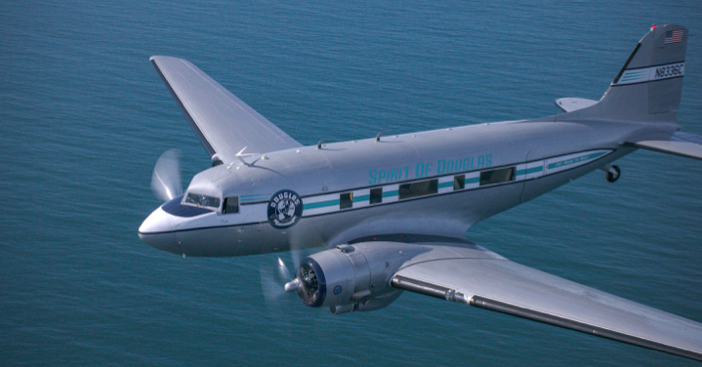
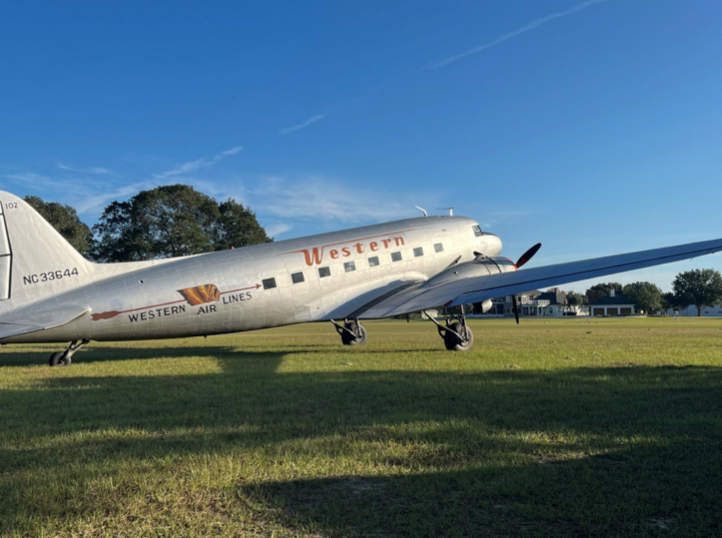
Western Airlines
Delivered to United Airlines as a DC-3-197E in April 1941, NC33644 was briefly impressed into the military after Pearl Harbor before being sold to Western Air Express in August 1942. After its service, this historic airliner has been in private ownership and returned to its 1940s Western markings.
Swissair
Originally assigned to the military with the USAAF, the Swissair DC-3 found itself passing through several private owners and operators, even film companies, before arriving in Switzerland where it ultimately received its current gleaming natural metal, red and white Swissair colours.

OUR MERCHADISE SYSTEM IS NOW 'LIVE'
Our merchandise system is now live shortly with the Official Clothing Range available to pre-order at pre-event prices for delivery at the end of October 2023